Before the Apollo missions, NASA had to learn how to live and work in space. The Mercury and Gemini programs paved the way for future moon missions. Dr. Amy Foster, Associate Professor of History at the University of Central Florida, sat with Brendan Byrnes to talk about the history and legacy of the Apollo program.
President Eisenhower signed the National Aeronautic and Space Act of 1958, creating the NASA we know today. One of its first programs: the Mercury Program, who's ultimate goal was to put a human in space and safely return them to Earth. The mission was accomplished with the safe launch and retrieval of astronaut Alan Shepard in 1961. By then, Kennedy had become the president and had a bigger idea for NASA.
"Space is kind of that open ground for possibilities. So after Alan Shepard flies- it was a suborbital flight, it went up, it came back down. A parabolic flight; fifteen minutes. It's after that flight that Kennedy makes the announcement that we're going to go to the moon." Dr. Foster said.
"And when I teach space history, I kinda call it like 'the most boneheaded decision' he could have made, because we only had that fifteen minutes of experience."
Gemini, the project that followed Mercury, continued sending orbital launches -- but no moon shot, yet. Gemini slowly progressed the technology and longevity of the technology to survive long enough for Apollo's and President Kennedy's ultimate goal.
For Apollo to succeed, it meant NASA had to figure out how to do long-duration flights, how to walk and work in space and how to rendezvous in space, which is when a spacecraft is able to meet up with another object and successfully docks and undock with it. For example, Gemini VII tested if humans could survive for 14 days in a micro-gravity environment, which would cover time needed to go to and return from the moon. All this work for an 8 day historical trip to the moon.
"It really is extraordinary. As historians when we try to look back and say what is the historical legacy of Apollo- it says a lot about the human spirit, it says a lot about gumption, it says a lot about [what] goal-setting can do to mobilize not only just a workforce, but a nation." Dr. Foster says.
A major infrastructure change also occurred during the pursuit of the Apollo mission: the Kennedy Space Center was created. All of the Mercury and Gemini had been previously launched at the Cape Canaveral Air Force Station.
Despite tragic accidents like the test flight of Apollo 1 that ended in a fatal cabin fire, Apollo finally launched humans to the moon 50 years ago today. The launch and moon landing continue to be a source of inspiration to many because of the seemingly impossible odds that were overcome to achieve it.
"We look up in the sky and we see the moon and it's that far away and we can't imagine getting there. It's still pretty extraordinary to think about the fact that after thousands of years, tens of thousands of years of human existence, finally in 1969, we step foot on another body." Dr. Foster commented.
"It's still extraordinarily mind-blowing and humbling, to find find yourself in a world where we can say, 'Yes, we have walked on the moon.'"

